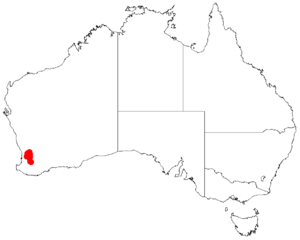Acacia cuneifolia facts for kids
Quick facts for kids Acacia cuneifolia |
|
|---|---|
| Conservation status | |
| Scientific classification | |
| Genus: |
Acacia
|
| Species: |
cuneifolia
|
 |
|
| Occurrence data from AVH | |
Acacia cuneifolia is a type of shrub that belongs to the Acacia family. It is found only in the southwestern parts of Australia. This means it is endemic to that area, growing naturally nowhere else in the world.
What Does It Look Like?
This shrub usually grows upright and can be a bit straggly. It typically reaches a height of 1 to 3 meters (about 3 to 10 feet). Its small branches are either smooth (called glabrous) or have very fine, soft hairs (puberulous).
The plant has small leaf-like parts called stipules, which are 1 to 3 millimeters long. Its leaves, known as phyllodes, stay green all year. They can be different shapes, but most often they are wedge-shaped (cuneate) or oblong-wedge-shaped. These phyllodes are 8 to 15 millimeters long and 2 to 6 millimeters wide. Each one has a clear central vein.
Acacia cuneifolia blooms from July to October, producing bright yellow flowers. These flowers grow in simple clusters called inflorescences. You can find one to six of these clusters where the leaves meet the stem. Each cluster has a round flower-head, about 3.5 to 4.5 millimeters across, filled with 23 to 26 golden flowers.
After the flowers, smooth seed pods form. These pods are strongly curved or loosely coiled. They can be up to 5 centimeters long and 4 to 6 millimeters wide. Inside, they hold dull, dark brown seeds. These seeds are oblong or slightly oval-shaped and are 4 to 5 millimeters long.
Where Does It Grow?
This Acacia shrub is native to a specific area in the Wheatbelt region of Western Australia. You can find it from York in the north down to Williams in the south.
It likes to grow on hills, among large rock formations made of granite, and along stony streambeds. It prefers sandy, clay, or loamy soils.


